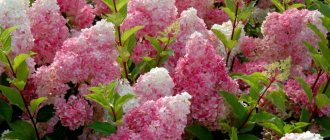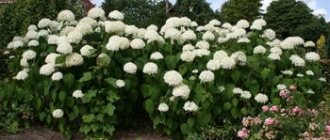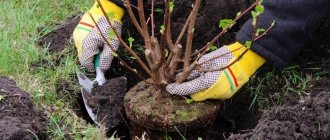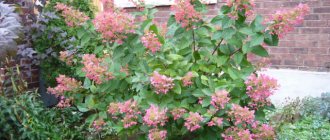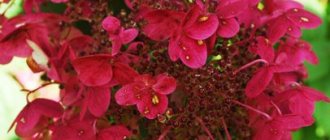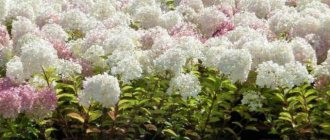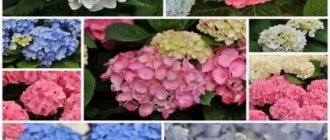To decorate their garden plots, gardeners choose the most spectacular plants. They should create beautiful single plantings or organic ensembles with various crops and shrubs. Preference is given to flowering specimens with well-developed branches and interesting shades of petals. One of the most beautiful varieties is Diamond Rouge hydrangea. This species is distinguished by its decorativeness and unpretentiousness, for which it has received high awards at international exhibitions.
Hydrangea Diamond Rouge is decorative and easy to care for
Description of Hydrangea paniculata Diamond Rouge
This is a beautiful compact bush. The height of Diamond Rouge hydrangea is about 1.5 m. The plant has an extensive superficial root system and prefers a cool climate and sufficient moisture. Hydrangea Diamond Rouge is famous for its unusually beautiful flowers, which slowly reveal all their decorative properties. Flowering begins at the end of June. At this time, large inflorescences appear, which gather into picturesque panicles. The initial color of the petals is white, however, pink tones soon appear. By the beginning of autumn, the color becomes rich red.
Attention! The color of Diamond Rouge hydrangea flowers may vary in different areas. Usually it depends on factors such as soil type, climate characteristics, the predominance of certain microelements in fertilizing, and water quality.
No less attractive are the leaves of the Diamond Rouge hydrangea. They have an original oblong shape and a velvety surface that is pleasant to the touch. During flowering, the leaves change color ranging from deep green to orange. Watching such metamorphoses is a pleasure; such a plant will become a worthy decoration for any garden.
Reviews from netizens
Gorgeous beauty paniculate hydrangea Diamond Rouge. The reddest of hydrangeas, unpretentious and winter-hardy. My love for hydrangeas began with the ordinary tree hydrangea, about which I already wrote a review. It was from this first acquisition that I decided that I would collect a large collection of these garden beauties. I started studying the names of varieties, care features and winter hardiness of hydrangeas. My second acquisition in the hydrangea collection: paniculate hydrangea Diamond Rouge. Red hydrangea was the most desired on my list of purchases. I've read a lot about her, but I've never seen detailed photos of her in the garden. Therefore, when I saw the bright packaging in our local garden store, neither the price nor the semi-dry sprig of the plant stopped me. The plant urgently needed resuscitation and intensive care)) For 700 rubles I bought a very small plant and did not even hope for flowering. I fed the hydrangea with fertilizer and made mulch from wood chips. My beauty came to life and flowers appeared on fresh thin branches. The first flowering began in early July; in the very heat, the hydrangea produced two flowers. The inflorescences are very large for thin branches and need additional support. I literally have them hanging on a metal support. And now it has started to bloom again. The white flowers gradually turn pink and become crimson-red. The saturation of the color depends on the acidity of the soil; hydrangeas love moist and acidic soil. Repeated flowering turned out to be more spectacular, the flowers are much larger than the previous ones and the sun no longer fry them. Without additional care and manipulation, the color of the flowers turns red within two to three weeks. And although at the moment my hydrangea is very small and does not exceed 30 centimeters in height, it is already a real beauty! Paniculate hydrangeas are quite winter-hardy and do not require shelter. But young plants can freeze, so for the first two years it is still necessary to protect the hydrangea from frost. Timely fertilizing with fertilizer, spring pruning, maintaining humidity and Diamond Rouge will delight you with its spectacular and long-lasting flowering. The variety is very beautiful and spectacular with abundant flowering. I would like to note that this is the only one of the hydrangeas purchased in spring that blooms. The rest are growing greenery and postponing flowering until next year. I recommend it, a beautiful and unpretentious resident of the garden. Thank you for your attention to the review, I hope it was useful)
Yulechka Krasotulechka
https://irecommend.ru/content/shikarnaya-krasotka-daimond-ruzh-samaya-krasnaya-iz-gortenzii-neprikhotlivaya-i-zimostoikaya
Hydrangea Diamond Rouge in landscape design
This beauty looks amazing in single plantings, but even in compositions it does not lose its special charm and appeal. The unusual colors of leaves and inflorescences turn this shrub into the first violin of the ensemble. Wherever Diamond Rouge hydrangea is planted, it will be in its place everywhere: under trees, in an open flower bed, along paved paths.
Hydrangea Diamond Rouge is planted in flower beds, lawns, along paths
Shrubs are often planted near benches, gazebos, in the center of lawns, and along artificial ponds. It is worth considering the flowering time of different species so that the composition looks harmonious throughout the summer.
Reviews from gardeners
Diamond Rouge paniculata hydrangea is grown in almost all regions of our country today. Reviews about this luxurious plant can be read in almost all floriculture publications. Exquisite flowering of huge inflorescences, fairly simple care, excellent combination in landscape design with other plants, high winter hardiness - these are the qualities for which gardeners value Diamond Rouge (hydrangea). This plant has minor disadvantages - the need for winter shelter in the northern regions and a high need for moisture, which does not allow leaving the plant for a long time (for example, when going on vacation).
Planting and caring for Diamond Rouge hydrangea
The care package does not involve any special difficulties. Gardeners who have already planted ornamental shrubs on the site can easily cope with the task, and even beginners can do it. One of the characteristic features of Diamond Rouge hydrangea is its ease of care. It takes a little effort to create favorable conditions for the plant for further growth and development.
Selection and preparation of a landing site
For Diamond Rouge hydrangea, a well-lit place is suitable, but without contact with direct sunlight. It is best to give preference to an area with diffused bright light or plant cuttings in partial shade. You should not place the shrub in a draft, as it will not be able to take root.
Another important point is the composition and quality of the soil. The soil should be loose, fertile and with sufficient organic matter. For good growth, a neutral or acidic environment is required. Alkaline soils are ideal, but sandy or calcareous soil will have a detrimental effect on the plant. This is practically the only drawback of Diamond Rouge hydrangea.
To naturally create an acidic environment, gardeners use regular whey. Beneficial bacteria will make the soil not only sufficiently acidic, but also nutritious. Before planting, the area must be completely cleared of weeds and loosened.
Rules for planting the hydrangea variety Diamond Rouge
Shrubs are planted in open ground in autumn or at the very beginning of spring.
The whole process consists of several stages:
- In a previously prepared area, dig a hole with a diameter of at least 70 cm; a smaller space will bind the roots.
- Afterwards, the soil must be enriched with organic matter and minerals, and then moistened abundantly. Soft fertile soil is combined with peat, rotted humus and sand. Additionally, urea is used, as well as potassium sulfate with superphosphate. All these substances are thoroughly mixed and scattered in an even layer at the bottom of the pit.
- A Diamond Rouge hydrangea seedling is placed in it, carefully straightening the roots so that they are not injured. The root collar is left on the surface. The hole is covered with soil from above, compacted and watered again. Well-moistened soil is the key to the growth of this shrub.
You should not plant other moisture-loving plants next to the Diamond Rouge hydrangea, otherwise they will steal precious moisture from the soil, which will lead to the death of the bush. The best neighborhood for paniculate hydrangea is saxifrage.
Hydrangea Diamond Rouge is easy to care for
Watering and fertilizing
An arid environment is detrimental to Diamond Rouge hydrangea, so it is watered quite often and abundantly. However, you shouldn’t be too zealous: there is a significant difference between well-moistened and overwatered soil. If there is little precipitation in the summer, watering is increased to several times a week. Before doing this, be sure to check the condition of the soil. It is important that after watering the soil does not become crusty. To do this, the top layer is carefully loosened, and in order to retain moisture longer, they resort to mulching (most often with peat or pine needles).
During the first time after planting Diamond Rouge hydrangea, nettle infusion is used as fertilizer. Every 10 days you need to introduce minerals. It is wisest to use fertilizers that dissolve well in water. They penetrate deep into the soil and nourish the roots.
Attention! The best organic substances for feeding Diamond Rouge hydrangea are bird droppings or manure, diluted to a safe concentration.
Pruning hydrangea Diamond Rouge
Decorative and health-improving pruning of shrubs is an integral part of care. Not only the attractive appearance of the Diamond Rouge hydrangea depends on this procedure, but also its ability to bloom profusely. In autumn, it is necessary to get rid of all old and non-viable branches, as well as wilted inflorescences. As a result, a maximum of 12 absolutely healthy shoots should remain.
In spring, pruning is done early, before the buds begin to bloom. No more than three buds are left on a young bush, about five on an old one. At the same time, all necessary fertilizers are applied. When rejuvenating Diamond Rouge hydrangea, all shoots are cut down to the stump. In two years, new branches will grow, and a beautiful lush crown will appear.
Preparing for winter
Hydrangea paniculata Diamant Rouge has good frost resistance, but to be absolutely sure it is still worth insulating it before winter. Gardeners use covering material only for young plants that are planted in the fall.
For adult specimens, the main thing is to protect the root system. For this, dry fallen leaves, peat, and rotted manure are usually used. If there is a threat to the branches, they can be additionally covered with a special frame, which will serve as a kind of greenhouse and protect the plant from the vagaries of the weather.
Features of the variety
Hydrangea paniculata diamond rouge is considered the most frost-resistant of all varieties of paniculata hydrangea, so its creators assure that even in the climatically harsh central zone of Russia it will take root well and feel great. If the plant freezes slightly in the harsh winter, the affected shoots are restored in the summer. Hydrangea blooms from late June-early July to September and during this time manages to change the color of inflorescences and leaves several times, which is in some way a unique property.
Caring for it is not particularly difficult for an experienced, knowledgeable gardener - the Diamond rouge variety is considered an unpretentious plant - however, in some matters the flower is quite capricious. In particular, capriciousness manifests itself when choosing soil: for the Diamond Rouge variety to show itself in all its glory, it needs organically rich, loose, fertile soil, moderately moist, with an acidity of at least pH 5.5. It should be remembered that its type affects the color of the flower: on the acidic side, the buds become brighter, and on the neutral side, they become paler. Calcareous and sandy soils are completely unsuitable for the variety, from which nutrients are very quickly washed out, due to which the plant begins to “starve”.
Among the characteristics of the variety, you should also pay attention to the following:
- its resistance to urban conditions and air pollution, so the flower can be grown even in a metropolis.
- love of moisture.
- thermophilicity.
Reproduction
The most effective way to propagate Diamond Rouge hydrangea is cuttings. Planting material is cut from strong and healthy branches and placed in a vessel with water for a while. After this, they begin to form a cutting, on which at least three internodes should remain.
It is best to propagate Diamond Rouge hydrangea from cuttings.
The lower cut is dipped into a solution of a growth stimulator and the cutting is placed in a previously prepared container (approximately 2/3 deep). Then he is kept in a room for a year. As soon as stable warmth is established, young bushes can be transferred to the garden.
Attention! It is also known to propagate Diamond Rouge hydrangea by seeds, but it gives very poor results. The seedlings grow and develop slowly. Even if the most comfortable conditions are created, the bush blooms no earlier than after 4 years.
Propagation of Diamond Rouge hydrangea by layering is relatively easy. All you need to do is make a groove in the ground (about 20-30 cm) and bend down strong annual shoots. Shallow cuts are made on them with a sharp blade. For fixation, take any convenient weight.
The only condition is that the top of the shoot must be located above the soil surface in a vertical position. The top of the groove is sprinkled with earth and watered. You won't be able to see the young shoots of the Diamond Rouge hydrangea until next spring. They are not separated immediately, but wait another year. With this method of propagation, all varietal characteristics of the mother bush are completely preserved.
Hydrangea propagation
Hydrangea Diamond Rouge reproduces in the following ways:
- cuttings;
- layering;
- seeds.
Propagation of this plant by seeds is impractical. The fact is that the seeds of this plant are very small, produce weak, unfriendly shoots, and a full-fledged bush, pleasing with flowering, can be obtained only after four years.
The most common propagation is by cuttings. Cuttings are cut from annual shoots. As a rule, their ripening occurs in June, when the bush becomes covered with buds. You need to know that cuttings cut in autumn and spring take root much worse.
Diseases and pests
Diamond Rouge hydrangea needs to be carefully monitored, as the risk of disease and pests is quite high.
Among the most likely diseases are:
- Powdery mildew. A disease of fungal origin, which is characterized by the appearance of dark spots. Infection occurs through the soil. The impetus for the development of the disease is excessive soil moisture against the background of high air temperatures. At the initial stage, a soap solution with copper sulfate helps a lot. In advanced cases, they resort to special medications.
Powdery mildew causes dark spots to appear on hydrangea leaves.
- Tracheomycosis wilt. Another fungal disease. Pathogenic spores penetrate deeply into the trunk and branches through the roots, which can lead to the death of the plant. The most effective prevention is treating the seedling with fungicides before planting. When a bush is damaged, the diseased parts are cut off and treated with a solution of potassium permanganate, including the soil around it. You can also use sulfur or ash in powder form.
Tracheomycosis wilt leads to plant death
The most dangerous pests of Diamond Rouge hydrangea include slugs, garden snails, aphids, spider mites, root-knot nematodes, fawn leaf beetles, etc. To prevent damage, you need to regularly inspect all parts of the plant, follow the rules of care, monitor the cleanliness of the soil and the condition of neighboring shrubs, trees and flowers. At the slightest suspicion, it is better to immediately carry out preventive treatment using folk or chemical remedies.
